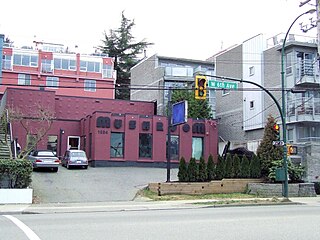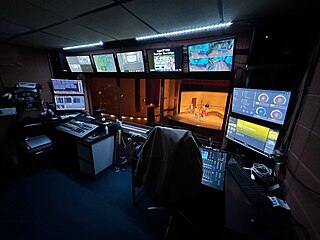
A sound film is a motion picture with synchronized sound, or sound technologically coupled to image, as opposed to a silent film. The first known public exhibition of projected sound films took place in Paris in 1900, but decades passed before sound motion pictures became commercially practical. Reliable synchronization was difficult to achieve with the early sound-on-disc systems, and amplification and recording quality were also inadequate. Innovations in sound-on-film led to the first commercial screening of short motion pictures using the technology, which took place in 1923. Before sound-on-film technology became viable, soundtracks for films were commonly played live with organs or pianos.
Real World Studios is a residential recording studio complex founded by Peter Gabriel and situated in the old Box Mill building in the village of Box, Wiltshire, England, near to the city of Bath. It is closely associated with the Real World Records record label, Real World Publishing, and the WOMAD Festival, whose offices are also based at the complex.

Ealing Studios is a television and film production company and facilities provider at Ealing Green in west London, England. Will Barker bought the White Lodge on Ealing Green in 1902 as a base for film making, and films have been made on the site ever since. It is the oldest continuously working studio facility for film production in the world, and the current stages were opened for the use of sound in 1931.
IMAX is a proprietary system of high-resolution cameras, film formats, film projectors, and theaters known for having very large screens with a tall aspect ratio and steep stadium seating, with the 1.43:1 ratio format being available only in few selected locations.

Cinerama is a widescreen process that originally projected images simultaneously from three synchronized 35mm projectors onto a huge, deeply curved screen, subtending 146-degrees of arc. The trademarked process was marketed by the Cinerama corporation. It was the first of several novel processes introduced during the 1950s when the movie industry was reacting to competition from television. Cinerama was presented to the public as a theatrical event, with reserved seating and printed programs, and audience members often dressed in their best attire for the evening.

A recording studio is a specialized facility for recording and mixing of instrumental or vocal musical performances, spoken words, and other sounds. They range in size from a small in-home project studio large enough to record a single singer-guitarist, to a large building with space for a full orchestra of 100 or more musicians. Ideally, both the recording and monitoring spaces are specially designed by an acoustician or audio engineer to achieve optimum acoustic properties.
Fantasound was a sound reproduction system developed by engineers of Walt Disney studios and RCA for Walt Disney's animated film Fantasia, the first commercial film released in stereo.

Vitaphone was a sound film system used for feature films and nearly 1,000 short subjects made by Warner Bros. and its sister studio First National from 1926 to 1931. Vitaphone is the last major analog sound-on-disc system and the only one that was widely used and commercially successful. The soundtrack is not printed on the film, but issued separately on phonograph records. The discs, recorded at 33+1⁄3 rpm and typically 16 inches (41 cm) in diameter, are played on a turntable physically coupled to the projector motor while the film is projected. Its frequency response is 4300 Hz. Many early talkies, such as The Jazz Singer (1927), used the Vitaphone system. The name "Vitaphone" derived from the Latin and Greek words, respectively, for "living" and "sound".

Carnal Knowledge is a 1971 American comedy-drama film directed by Mike Nichols and written by Jules Feiffer. It stars Jack Nicholson, Candice Bergen, Art Garfunkel, and Ann-Margret, with Rita Moreno and Cynthia O'Neal.
James P. Nichols is an American recording industry executive producer and master engineer.

Mushroom Studios was a music recording facility located in Vancouver, British Columbia, Canada with a long history in Canadian music. It has now been relocated to Toronto, Ontario, Canada.
MOS is a standard filmmaking jargon acronym used in production reports to indicate an associated film segment has no synchronous audio track.

The control booth, control room, lighting box, technical booth, tech booth, or just booth used by television, film or theatrical technicians is the area designated for the operation of technical equipment, lighting controls and sound board, while the control booth in industrial operations is used to house employees and sensitive equipment in all types of locations such as process control pulpits, loading racks, dredge cabs, loading docks and more. Often one or two followspots may be located in the booth as well. In a theater, it is generally an enclosed space with a large sliding window with a good view of the stage centered in the back of the house. It may be on the ground floor or at the balcony level. In a film or television production, it might be in a trailer or other space near the studio.

Optical sound is a means of storing sound recordings on transparent film. Originally developed for military purposes, the technology first saw widespread use in the 1920s as a sound-on-film format for motion pictures. Optical sound eventually superseded all other sound film technologies until the advent of digital sound became the standard in cinema projection booths. Optical sound has also been used for multitrack recording and for creating effects in some musical synthesizers.

An audio engineer helps to produce a recording or a live performance, balancing and adjusting sound sources using equalization, dynamics processing and audio effects, mixing, reproduction, and reinforcement of sound. Audio engineers work on the "technical aspect of recording—the placing of microphones, pre-amp knobs, the setting of levels. The physical recording of any project is done by an engineer…"

A film, also known as a movie or motion picture, is a work of visual art that simulates experiences and otherwise communicates ideas, stories, perceptions, emotions, or atmosphere through the use of moving images that are generally accompanied by sound and other sensory stimulations. The word "cinema" is a shortening of the word "cinematography" and is used to refer to either filmmaking, the film industry, the overall art form, or a movie theater.
Flashpoint Chicago was a campus of Columbia College Hollywood, a private liberal arts college with a focus on communication, media arts, and contemporary storytelling. Flashpoint Chicago was located in downtown Chicago, Illinois. It closed at the end of the 2021–2022 academic year.

Dubway Studios is an audio post and music production facility located in the Financial District of Manhattan, New York City. Services offered at Dubway Studios include tracking, recording, mixing, mastering, music production, voice-over sessions, and remote connections via Source-Connect, phone patch, and Skype.
Synchron Stage Vienna is a recording facility specializing in recording large orchestras and film music. The landmark protected building, formerly "Synchronhalle" of the historic film lot "Film City Vienna" in the Austrian capital's 23rd district is operated by Vienna Symphonic Library.
The Sweet and the Bitter, also known as Savage Justice, is a 1967 Canadian film directed by James Clavell.











